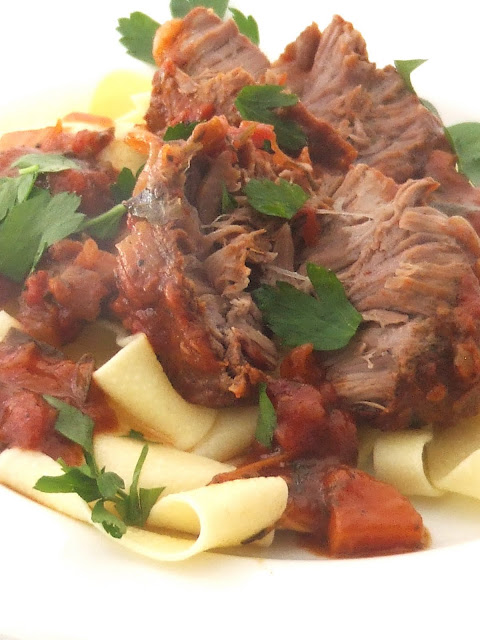The sheer cheek of it
 |
| Guisada de Bochechas ( Pork cheek Ragù with pappardelle) |
Bochechas de porco
A throwaway cut, championed by a handful of reputable chefs, and suddenly it´s the latest in food fashion: are pigs’ cheeks the new pork belly? Ricardo and Sara at Amore Vero champion some of the tastiest cooked pork cheeks in the Algarve and likewise Chef Marco does his own cheeky cha take at Cha com agua Salgada
 |
| Cheek by jowl, pure cheek... |
 |
| ...and Portuguese style |
This brought a smile to my cheeks
"Nigella Lawson keeps a secret stash of pigs ears in her freezer that she deep-fries for a crispy, solitary snack".
The most important thing to remember when you’re cooking pork cheeks, is not to cook them too fast. Not one for the barbecue, this cut demands long, slow cooking in order to tenderise the muscle fibres that spend all day chomping at the pig’s trough. Have patience and you will be rewarded with meltingly tender morsels of meat that you can eat with a spoon, and that snuggle up perfectly to a warming blanket of creamy mash.
Just as they sound, they are the cheeks of the pig. A delicacy that normally weigh 3-5 oz a piece.They have a very rich flavor and a lot of tough protein, which means that they are chewy, but when you slow cook them, those proteins break down to give them a beautiful melting texture. Cook them until they easily pull apart with a fork (you don’t actually have to pull them apart). Ordinarily, I´d suggest you do this in a cast iron pan or slowly in the oven. You can dry rub them with salt and pepper and any herb that you like. Rosemary is always a good choice. I would sear them over high heat until they brown on both sides, then move them away from the direct heat and let them finish at 250C for at least 2 -3 hours.
If you prefer, you can always do them in a cast iron pot which allows you to collect the juices. Then you can saute a little garlic in the pot and finish a sauce by reducing wine or peach slices. Or both,very nice.
Anyway, use your imagination as long as you sear them and then finish them low and slow.
Do you want to be a cheeky chappy - then here´s how
Pork cheek Ragù with pappardelle
The best part about this recipe is that it’s simple and requires very little attention beyond the prep. Just brown the meat and refogado to create a flavourful fond on the pan, toss in all the other ingredients, then let it cook over low heat for a few hours. When you come back you’ll be greeted by a thick reduced sauce and glistening collagen laden meat that falls apart when prodded with a fork.
The aroma is quite intoxicating, and whether it’s served with al dente pappardelle or with a crusty slice of fried bread,Portuguese style. Whichever, you’ll be richly awarded for such a meager amount of work. The left over sauce freezes well and can be served up as a simple supper with any another type of pasta.
Allow 2 Bochecas ( pork cheeks )per person
1 medium onion chopped
1large carrot chopped
1 stalk celery chopped
3 cloves garlic minced
1/2 Cup white wine
1 Can chopped tomatoes
5 sprigs fresh thyme
handful of fresh basil leaves
1 bay leaf
1 tbsp dried shiitake mushroom (optional)
Generously salt and pepper both sides of the cheeks . Heat a small casserole until hot. Add the pork, fat side down and fry undisturbed until browned. Flip, then brown the other side. You may have to do this in 2 batches. The brown fond on the bottom of the pan is where the sauce gets most of its flavour so make sure you build up a nice thick layer without burning it.
Turn down the heat and set the pork aside. Add the onions, carrot,celery and garlic to the pan. Use the vegetables to scrape the brown fond off the bottom of the pan and fry until soft and fragrant. Deglaze the pan with the wine turning up the heat and boiling until the mixture is a thick consistency. This incorporates all that good flavour into the sauce while reducing the amount of liquid so your sauce doesn’t end up watery.
Add the tomatoes, thyme, marjoram and bay leaf stirring to combine.If using, take a microplane or other zester to grate 1 tablespoon of dried shiitake mushroom into the ragù. Return the pork with the collected juices back into the pot. Submerge the meat in the sauce, turn the heat down to low and partially cover with a lid. Simmer for 2-3 hours or until the jowls come apart easily with a fork.
Skim off any excess fat with a spoon then remove the pork from the sauce and roughly chop or pull apart the meat then return it to the sauce. If you are serving it with pasta, put the cooked pasta in a bowl with some sauce and toss to combine along with some minced parsley for color. .
The versatility of the chap:
it can be sliced into lardons for a carbonara.
it can be sliced into lardons for a carbonara.


I had never thought of eating these . . . I shall definitely be nagging my local butcher!
ReplyDeleteNag and ye shall be rewarded!!!!
ReplyDeleteMy first trip to Spain and {Portugal last year. We had some wonderful slow cooked pork cheeks. now back in Tasmania and I have managed to find a butcher who can supply me with cheeks. I'm looking forward to trying this recipe sometime in the next week.
ReplyDelete